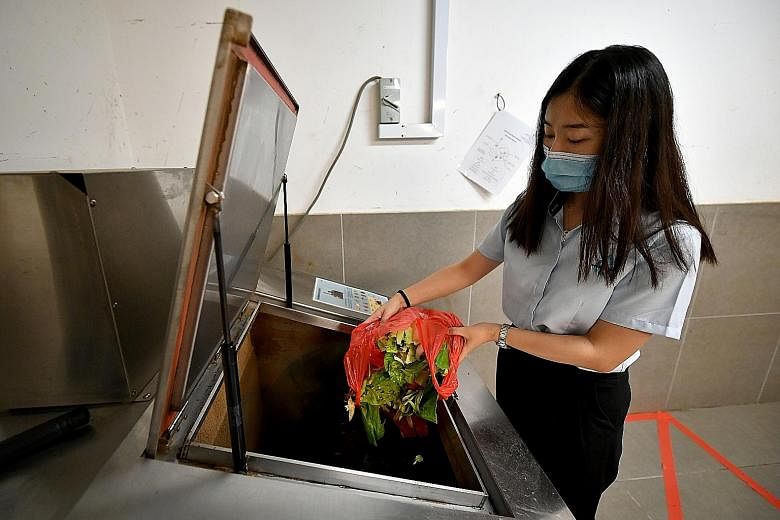There is a saying in Chinese, "wu yi xi wei gui". It means that which is scarce is precious.
In tiny Singapore, despite having no natural resources, few things are actually scarce. And the one thing we rarely seem to run out of is food. Bustling hawker centres, restaurants at full house and well-stocked supermarket shelves are constant reminders that food is always easily within reach here.
Perhaps this apparent abundance is why a nation of food lovers takes food for granted: In 2019, 744,000 tonnes of food ended up in the bin, about 33 per cent more than what we threw away as a nation in 2007. The mountain of food waste translates to about 51,000 double-decker buses in weight, or two bowls of rice per person each day.
Not knowing the real costs of food waste is a reason why we fail to value food.
For the average consumer here, food spending takes up a smaller proportion of our disposable income than those living in developing countries.
Figures from the United States Department for Agriculture show that the average person in Singapore spent only 7 per cent of total consumer expenditure on food consumed at home in 2016, while that figure is 26 per cent in Thailand, 31 per cent in Indonesia and 42 per cent in the Philippines.
What this means is we feel less of a pinch when throwing away food compared with our immediate neighbours.
On average, a household in Singapore throws away 2.5kg of avoidable food waste - food items that could have been consumed if better managed - every week. Taken together, all households across Singapore throw away about $342 million worth of food every year.
Over the past few years, there has been a lot of emphasis by the National Environment Agency (NEA) on what consumers can do to reduce food wastage, such as not ordering more than what they can eat when dining out, or being open to buying "ugly" food - produce with superficial imperfections that usually end up in the trash because of them.
But a big piece of the food waste puzzle is still being overlooked: businesses.
WASTEFUL BUSINESSES
NEA estimates that 40 per cent of the food waste generated in Singapore comes from the commercial and industrial sectors. This includes hotels, restaurants and supermarkets, as well as food manufacturers.
Currently, businesses might not feel strongly about reducing food waste simply because they are not aware of the true costs of food waste.
Ms Pratima Singh, senior manager for public policy and thought leadership at The Economist Intelligence Unit, said getting that data can be critical in making the business case to reduce food waste.
"Unless I know how much I'm wasting or how much money I'm leaving on the table as a result, it will be difficult for me to make any adjustments," she added.
For some businesses, figuring out ways to throw out less food can be more costly than discarding it.
This could be due to food prices not reflecting the real costs of producing food, which include externalities such as pollution and the generation of greenhouse gases in the source country.
For instance, gathering food waste data and analysing that data over time can be key to helping firms manage their inventory better and carry out more effective demand planning, but if the costs of investing in such technology and analytics outweigh the costs of throwing food out, businesses are likely to opt for the latter, said Ms Singh.
With this lack of a strong business case to reduce food waste, businesses - which are ultimately concerned with their bottom line - cannot be relied on to reduce food waste out of goodwill.
During the course of working on a six-part food waste series, which was a Sunday Times collaboration with DBS Bank, I was surprised at the lack of data that I could gather about the amount of food waste generated at each stage of the food supply chain.
For instance, most major supermarket chains I spoke to declined to reveal how much food waste was generated at their stores yearly. Arguably, their reluctance to divulge such information could be attributed to a fear of public backlash, or maybe a failure to track and record food waste information in their operations.
But more disconcerting to me was that NEA - the government agency that oversees waste management in Singapore and which had spearheaded the Zero Waste Masterplan launched in 2019 - was not able to shed light on figures on the overall food waste generated by supermarkets here.
Why is the agency not keeping track of this closely when supermarkets are notorious for throwing out large amounts of edible food?
While the masterplan initiative is a reflection of the Government's efforts to focus on sustainability and environmental issues in recent years, bridging that information gap and making that data transparent should be a priority if Singapore indeed wants to work towards becoming a zero-waste nation.
If there is no awareness of how much food waste individual stakeholders in the supply chain are generating, how can Singapore begin to even resolve the issue?
So far, campaigns under the masterplan have been mostly targeted at raising awareness among consumers.
Such efforts are commendable because educating the public - even on simple things such as how to read labels and differentiate between "best before dates" and "expiry dates", and a willingness to buy less-than-perfect produce from reduced-to-clear sections at supermarkets - will go a long way in the national battle against food waste.
Cosmetic filtering, for instance, accounts for a significant proportion of the food that is thrown out by businesses. From bruised apples to vegetables with yellowed leaves to chickens that are not of the "right size", firms point to picky consumers with high expectations of the sometimes ridiculous standards they expect of the produce they would buy.
But how many of these industry standards are actually made in close consultation with customers, and how many are self-imposed? Much of this "unsightly" produce never makes it to the shelves in stores, and consumers are rarely given a choice as to whether or not to buy such produce.
There is value in these food products that are originally destined for the bin, and local social enterprises Treedots and UglyFood have proved this by taking discarded "imperfect" food such as chicken parts and vegetables and made a business from selling it at discounted prices to consumers.
Their successful business models show that there is value in food that would have been tossed out at every stage of the food supply chain.
An NEA study in 2019 also showed that 32 per cent of respondents were open to buying fruits and vegetables with slight imperfections, up from 23 per cent in 2015.
In a survey commissioned by The Sunday Times for the food waste series, 45 per cent of respondents also said they buy fruits and vegetables from the reduced-to-clear sections at supermarkets occasionally, frequently or all the time. About two-thirds of respondents who buy from the sections said they do so in order to save money.
This shows that if prices are right, cosmetically filtered produce do have very willing takers, but it boils down to whether retailers like supermarkets are willing to do more to drive sales for this "ugly" produce.
For a decision laden with moral consequences such as food waste, we cannot rely entirely on profit-driven businesses to do the right thing, especially if there is no economic incentive to do so.
When businesses donate unsold items to the needy, for instance, it is more of a moral imperative rather than a decision that makes business sense. Redistributing food, after all, involves incurring extra costs which undermines profits.
At the moment, a handful of charities here, like Food From The Heart, are rechannelling food that would otherwise have been binned to those who need it more, such as welfare homes and halfway houses. But leaving these organisations to fill the gaping hole in the food waste problem is like putting a band-aid on a gushing wound.
GOVERNMENT INTERVENTION
If businesses have systems in place to track food waste, there might not be a significant amount of such waste to warrant redistribution.
With enough information on food wastage, the Government will also be better equipped to step in to resolve this market failure.
This can be done either by creating a disincentive for food waste generation using fines or imposing a tax. The Government could even grant tax exemptions for businesses which donate excess food, for instance.
Supermarkets in France, for example, have been banned since 2016 from throwing away unsold food. The law forces them to donate it to charities or food banks.
Denmark, one of the leaders in food waste reduction in Europe, launched a subsidy scheme in 2016 to support projects tackling food waste, from production to consumption. The country celebrated its inaugural National Food Waste Day last September to raise awareness of the issue.
FOOD WASTE AN ETHICAL ISSUE
One-third of food produced for human consumption - or about 1.3 billion tonnes annually - is estimated to be lost or wasted globally, according to the Food and Agriculture Organisation of the United Nations.
This is while 800 million people in the world go to bed hungry every night.
This makes food waste a moral issue not just because throwing out food adds to the trash the world generates, but also because that food could have gone to those really in need.
With businesses ultimately concerned with their bottom line, we cannot depend on them to reduce food waste or redistribute such food out of compassion. The authorities must step in to demand more accountability from businesses, for instance, in the form of food waste audits.
Only when enough information on how much stakeholders are wasting is available can there be measures such as taxation to reduce wastage, and work towards being a zero-waste nation can begin.
As a nation that imports most of its food, it would be easy for Singapore to disregard the food waste issue. It would be convenient for us to ignore the environmental effects, such as pollution and the emission of greenhouse gases, on food-producing countries from having to keep up with the global demand for food.
It would be easy to disregard the far-reaching consequences of throwing out vegetables or fruits that have gone bad in the fridge without a second thought.
But if we are sincere about doing our part in the global fight against climate change, we need to start valuing food, and not just love it.


